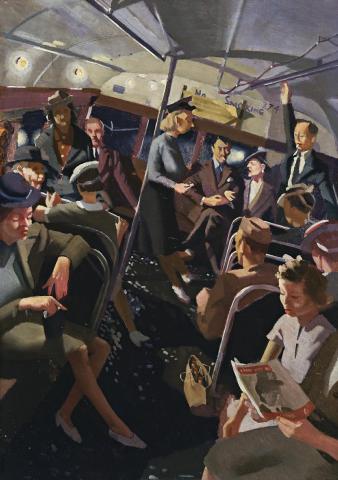THE NIGHT BUS, c.1933
Herbert Badham
oil on board
34.5 x 24.5 cm
signed and inscribed verso: ‘H Badham / East Sydney Tech. / College / “The Night Bus” / Price: 15 Guineas’
Private collection, Sydney
Savill Galleries, Sydney
The Hicks Family Collection, Melbourne
Although Herbert Badham was a painter much given to the urban scene and daily round, the theme of performance runs as a leitmotif throughout his art. This is obvious in such subjects as Kings Cross Fair, 1945, and the interior theatre scene, Entr'acte, 1945, although movement in each has been fixed as in a photograph. It continues in the street and pub scenes - the hand raising a cigarette to the lips is frozen, as with the beer glass. We, the viewers, provide the audience. Even the lighting within his pictures adds to the theatrical mood, combined with a compositional organization that speaks of theatre sets and the stage of life on which we all perform. In The Night Bus, the interior lights highlight the different figures and their gestures, all still, fixed in the moment. A woman reads the evening newspaper, the painted red finger nails and hands of another are transfixed as in a still life, while at the rear of bus they smoke, a part-covered 'No Smoking' sign signifying that typical trait in the Australian character, its healthy distaste of authority. In a thematically related painting, Travellers, 1933, another part-covered sign at the end of the crowded tram threatens a £2 penalty. The passengers take not the slightest notice as the matchbox is passed by the cigarette-smoking man to another with a pipe in his mouth. In the era of the Great Depression, mateship is more important than regulations.
In Travellers and The Night Bus the complete commonplaceness of the scene is transformed by Badham's creative skills into a scene not only redolent of its time, but also intriguing through its ordinariness highlighted into something surreal. The composition is angled to give a feeling of the rocky ride, the occasional lurching of the motorbus. This is aided by Badham's use of perspective, in which he had a special interest, it being the subject of a thesis he wrote on its theory and practice. Here its idiosyncratic employment, the dissection and division of the picture surface, use of shallow space, and web of chiaroscuro are all drawn together with line and light. While Badham was interested in painting scenes of leisure, of everyday scenes in pubs, at the theatre, or the fair, his approach was entirely objective. He was a bit of a distant observer. There is more than just a touch of Alfred Hitchcock in his art for Badham, like Hitchcock, occasionally appears in his own paintings as one of the crowd. Through his wit and penetrating observations of humanity, Badham reveals himself as a skilled practitioner of the mime of art.
DAVID THOMAS
